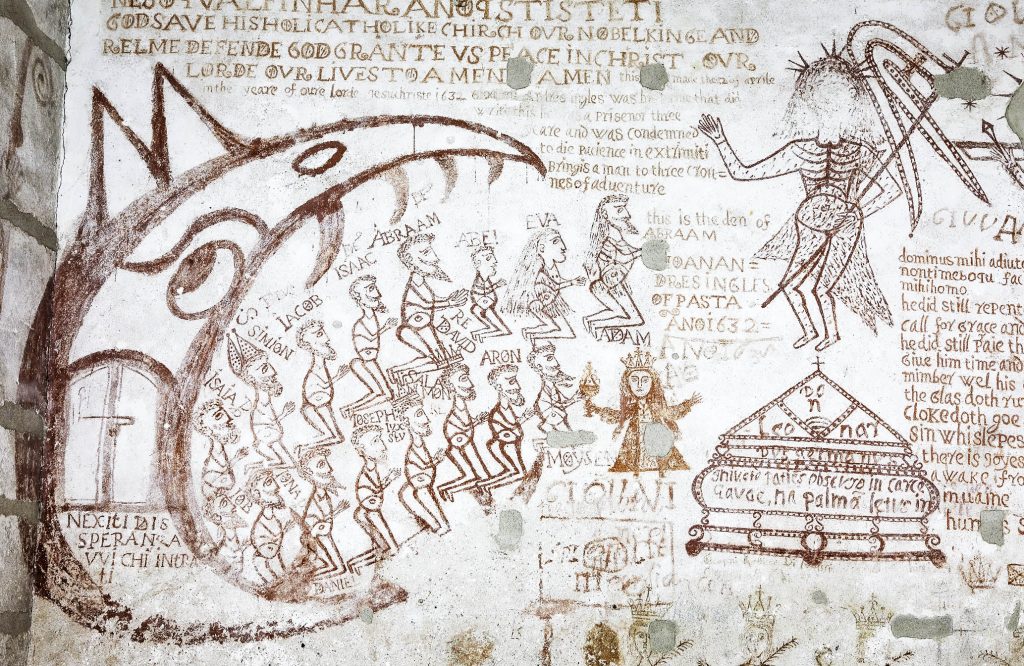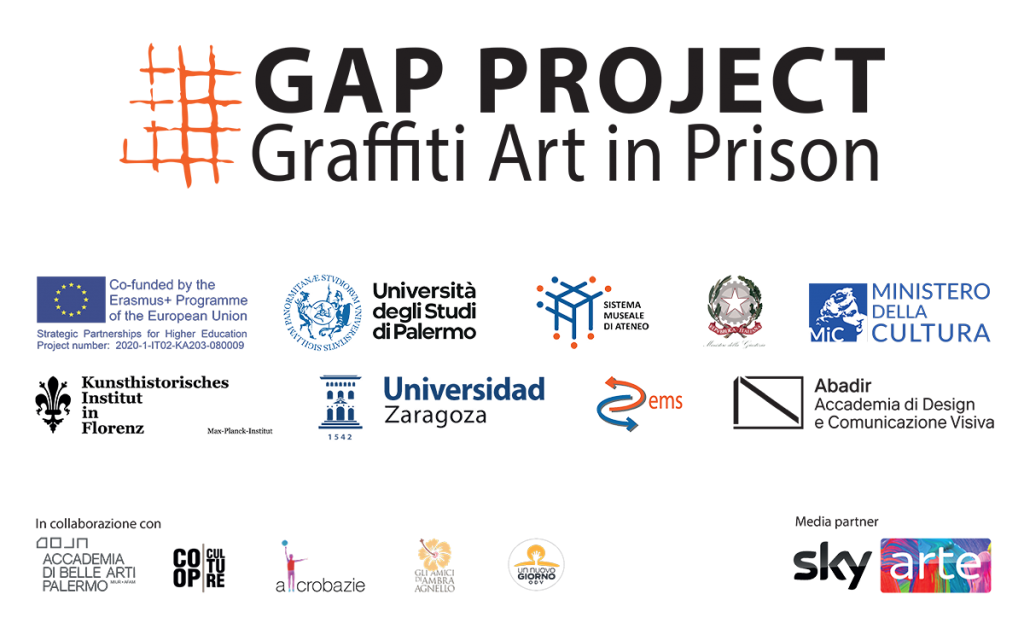GAP – Graffiti Art in Prison

The GAP project “Graffiti Art in Prison” of the Simua-Museum System of the University of Palermo is the result of a partnership with the Kunsthistorisches Institut in Florenz – Max-Planck- Institut, the Dems of the University of Palermo, the University of Zaragoza and the Academy of Art and Design – Abadir in Catania. It is financed in the ambit of the European program Erasmus+ (Strategic Partnerships for Higher Education), with the patronage of the Ministry of Justice, DAP-Department of Penitentiary Administration and the Ministry of Culture.
The three-year project (2020-2023) coordinated by Gabriella Cianciolo, Laura Barreca and Gemma La Sita, presents an experimentary model based on interdisciplinary research through horizontal and mutual collaborations between university and the penitentiary contexts, and includes artists, teachers, scholars and experts, and 20 international PhD students in the humanities and sciences.
The GAP project relates one of the most important cultural sites in Sicily, the Steri Prisons of the Inquisition in Palermo, and its palimpsest of writings and drawings painted on the walls, with the artistic expressions in today’s prisons, proposing a new training and educational path that combines scientific research, didactic and artistic activities and social commitment.
The goals of GAP are numerous: to investigate the Steri graffiti and relate them to other examples of prison graffiti and murals, both historical and contemporary, to train a group of PhD students through new learning processes that use the languages of contemporary arts and the relationship with current prisons.
The project is focused on the value of inclusion and through participatory approaches it explores “empathic” ways of education and interaction between different actors, without distinction of origin.
From a scientific point of view, various places of imprisonment will be considered and also the artistic responses to these specific environments, in their multiple dimensions: material, physical, psychological, spatial and temporal.
The term prison can be interpreted as a detention center, a concentration camp, a psychiatric hospital or, in general, a condition of deprivation and lack of freedom. Methodological issues related to graffiti will also be explored, such as the relationship between freedom and censorship, the boundaries between art and vandalism, and the theory and practice of graffiti in different times and places, including its role as political protest and critique of the system. An important part of the project is to consider graffiti as a contemporary art practice and bring it into today’s reformatories through the realization of art programs for detainees in order to improve their living conditions and contribute to their rehabilitation and reintegration into society.
THE PRISONS OF THE INQUISITION
During the seventeenth and eighteenth centuries, the Steri complex was the headquarters of the Tribunal of the Inquisition and its prisons, where there are still preserved many graffiti of inestimable historical, artistic and anthropological value. This unique monument/document represents both the core and the starting point of the project, which will also take into consideration the graffiti found in other Inquisition prisons, such as Narni (Italy) and Zaragoza (Spain). These prisons were crossroads of the Mediterranean diaspora and served as a meeting point for different religious faiths, on whose walls the prisoners left traces of their presence and messages to be deciphered: a ‘chorus of voices’ with different levels of meaning and a high level of complexity.
6 INTENSIVE STUDY WEEKS
The didactic activity plays a key role and it consists in organizing six intensive study weeks during which the PhD students and scholars will be involved in facing different issues:
Palermo, October 2021 Graffiti, drawings and wall writings from the Inquisition in Palermo
Palermo, May 2022 Caesura, censorship, imagination: artists, historians and anthropologists in dialogue
Cologne, July 2022 Marking the space: the wall as a heterotopic place
Palermo, October 2022 From sign to symbol: new educational approaches for prisoners
Zaragoza, January 2023 Management of Cultural heritage: the reuse of prisons as spaces for contemporary art
Firenze,March 2023 Ways of expression and resistance in prison environments: graffiti in their devotional and political dimension
The formula adopted for each week of intensive study includes frontal lectures, seminar activities and guided tours, with an interdisciplinary approach that will allow students to confront the themes from different perspectives and with different methodologies.
THE ARTISTS
The project also foresees the involvement of artists coming from different fields such as video, photography, design, participatory actions, urban scale interventions, whose results will be presented in an exhibition project at the University of Palermo in 2023.
Matilde Cassani, will work with a group of inmates and PhD students for the project “Operazione grigi cortili”, that will take place inside the Ucciardone Prison in Palermo;
Elisa Giardina Papa will produce a series of works inspired by an historical theme and she will conduct a workshop with doctoral students and detainees in the Malaspina juvenile prison;
Stefania Galegati together with a group of inmates and PhD students will activate a participatory project dedicated to the horizontal sharing of knowledge in the Pagliarelli Prison;
Giovanna Silva will be involved in a photographic project on the architecture of Palermitan prisons, which will be included in the final publication edited by Humboldt Books;
David Mesguich, street artist, will realize an ephemeral sculpture inside a Florentine prison with the collaboration of PhD students and inmates;
PARTNERSHIPS AND COLLABORATIONS
The GAP project is realized in collaboration with the Association “Un Nuovo Giorno” committed in the Pagliarelli Prison, with the Association “Gli Amici di Ambra Agnello” and with “Acrobazie”, “Coopculture” and the Academy of Fine Arts in Palermo.
DOCUMENTARY
The documentary will be filmed by Chiara Agnello, director and screenwriter, in partnership with the Italian thematic television channel SKY ARTE. It will be a testimony of the artistic actions and the work carried out with inmates and doctoral students inside the detention institutions in Palermo and Florence.
PUBLICATION
The project foresees the production of the scientific publication “Graffiti Art in Prison”, which will include and present the scientific evidence of the project, including the different interdisciplinary aspects that have characterized the scientific, artistic and social program of GAP.
ITINERANT EXHIBITION
Before the conclusion of the project, an exhibition will be organized in which the works created by the artists involved and the process that led to their realization will be presented through multimedia languages. The exhibition will begin, presumably in May, from Spain, will pass through Germany and finally it will arrive in Palermo.
PERMANENT EXHIBITION
At the end of the project, the traveling exhibition will become a permanent exhibition in the Steri prisons.

